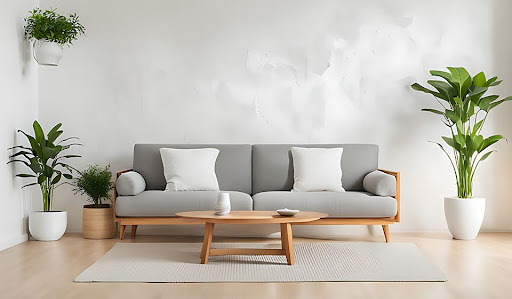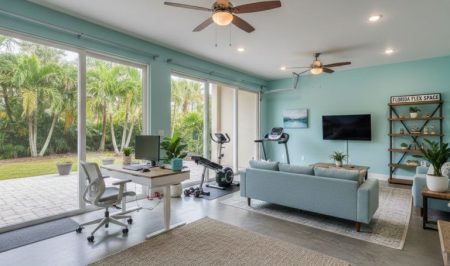Whether you’ve just moved into a new space or you’re looking to breathe new life into your abode, interior design can transform your home from ordinary to extraordinary. While professional interior designers seem to have a magic touch, there are secrets you can employ to achieve a polished, cohesive look on your own. Here are five interior design secrets to help you spruce up your home and create a space that’s both beautiful and functional.

Fix Before Adding: The Key To A Complete Look
When thinking about sprucing up the home, we all have visions of new additions we’d love to make. However, it’s imperative that you prioritize repairs. After all, an untreated leak could ruin the new wallpaper or furniture you’ve purchased. So, you’ll end up wasting time and money by completing two makeovers instead of one.
Learning simple tricks like how to repair click-lock flooring will put you in a far stronger position. You can restore the property to its former glory quickly and cheaply, even if you have to replace a plank. Similarly, you should look for low-maintenance items so that any future fixes are minimal.
Besides, doing more with a room’s existing features will often show that fewer new additions are needed. And those that are can be integrated with far greater ease.
The Rule of Thirds: Balance and Harmony
One of the most fundamental principles in design is the rule of thirds. This concept, borrowed from photography, involves dividing space into a 3×3 grid and placing key elements along these lines or at their intersections. In interior design, this translates to creating balance and visual interest throughout a room.
To apply this rule, imagine your room divided into thirds both horizontally and vertically. Place your larger furniture pieces, artwork, or focal points at these intersections or along these lines. For example, in a living room, you might position your sofa set along the bottom horizontal line, with a large piece of art centred at the upper right intersection.
This approach prevents rooms from feeling too symmetrical or static, introducing a subtle dynamism that makes the area more engaging and inviting.
Layering Textures: Add Depth and Dimension
Texture, an element often ignored in interior design, acts as a quiet messenger of warmth and personality within a room. Start with your larger pieces—perhaps a smooth leather sofa or a rough-hewn wooden coffee table. Then, build upon this foundation with smaller elements. Add plush throw pillows, a nubby wool rug, or gauzy curtains. Mix materials like glass, metal, wood, and fabric to create a rich tapestry of textures. By carefully combining different textures, you can transform a flat, one-dimensional space into a multi-layered, inviting environment that engages all the senses.
The 60-30-10 Colour Rule: Harmonious Palette
Colour can make or break a room’s design, and achieving the right balance can be challenging. This is where the 60-30-10 rule comes in handy. This principle suggests dividing the colours in space into percentages: 60% for the dominant colour, 30% for the secondary colour, and 10% for an accent colour.
The dominant colour is usually applied to walls, large foundation pieces, or rugs, to set the overall tone of the room. The secondary colour complements the dominant one and can be incorporated through smaller foundation pieces, curtains, or armchairs. The accent colour adds a pop of interest and can be introduced through accessories, artwork, or throw pillows.
This rule provides a framework for creating a cohesive colour scheme that feels balanced and intentional. It allows you to incorporate bold or trendy colours without overwhelming the space, ensuring that your room feels put together rather than chaotic.
Lighting as a Design Element: Setting the Mood
Lighting, called the ‘accessories of the home’, is essential in determining the mood, usability, and beauty of a room. It goes beyond brightening up 9space; it involves creating an atmosphere, showcasing design features, and improving the overall lifestyle. If you are seeking to brighten your living space with both elegance and function, consider these insightful suggestions:
Incorporate multiple light sources at different levels to create depth and ambience. This might include overhead lighting, table or floor lamps, and accent lights. Consider the colour temperature of your bulbs – warmer lights create a cosy, intimate atmosphere, while cooler lights can make a space feel more energetic and bright. Whenever possible, maximise natural light with strategic window placements, airy curtains or blinds.
The Power of Negative Space: Less is More
One of the most counterintuitive design secrets is the importance of negative space, also known as white space. While it might seem that filling every corner would make a room feel complete, the opposite is often true. Negative space is essential for creating a sense of balance, preventing visual clutter, and bringing a soothing vibe to your eyes.
This does not mean filling every shelf, table, or wall with decorative items. Instead, curate your possessions carefully. Choose a few statement pieces and give them room to breathe. This approach not only makes your chosen items stand out but also creates a sense of calm and sophistication in the space.
Concluding Thoughts
Implementing these five interior design secrets can dramatically transform your living space. The ultimate goal of interior design is to create a space that not only looks beautiful but also feels comfortable and functions for your lifestyle. After all, the best-designed homes are those that reflect the unique personalities of the people who live in them.






